
Large tree to about 40 m tall with straight trunk and narrow crown. Bark greyish-orange and yellow, peeling in plates, smaller detail jig-saw like. Buds conical to cylindrical, resinous, scales mostly pressed down. Young shoots greenish-brown. Leaves mostly in 3's, rarely in 2's, 4's or 5's, stiff and sharp-pointed, 13-28 cm long, pale green; sheaths persistent, to about 1.5 cm long. Cones more or less symmetrical, ovoid, 7-15 cm long, pale at first, becoming reddish-brown, deciduous; scales thin with a stout, hooked prickle. Seed mottled, wing about 2.5 cm long.
Naturalised in South Australia and on the North and South Islands of New Zealand.
W North America where it grows naturally in coniferous forest on the lower mountain slopes and in valleys; the most widespread species of pine in western North America and growing in a variety of soils.
Jigsaw patterning on bark scales; thick, densely-packed leaves; cone scales with a short, sharp, backward- or outward-pointing prickle. Two subspecies may be distinguished: 1. cones mostly 8-15 cm long; leaves mostly in 3's subsp. ponderosa 2. cones mostly 7-10 cm long; at least a few leaves in 2's subsp. scopulorum.
A: Mt Gambier (Bot. Gds); Stirling ('St Vigeans' 17 Laurel Rd ptd c. 1882). NSW: Batlow (Pilot Hill Arboretum); Orange (Duntry League Golf Club); Ournie (Jephcott Arboretum - many trees); Sydney (Hunters Hill, Catholic Theological College c. 30 m tall); Uralla (Alma Park, several). ACT: Gunghalin (homestead, left hand side entrance); Old Forestry School (S side); Royal Canberra Hospital; Yarralumla (Dunrossil Drive; Nsy near office). VIC: Ballarat (Bot. Gds); Beechworth (Queen Victoria Park; Town Hall Gardens); Buninyong (Bot. Gds); Castlemaine (Bot. Gds, 42 m in 1991, possibly the tallest specimen in Victoria); Creswick (Sawpit Gully by original nursery ptd c. 1880, 40m tall); Daylesford; Domain (outside National Herbarium of Victoria); Melbourne (Royal Bot. Gds, Hopetoun Lawn); Narracan (State School, 41 m in 1993). TAS: Hagley (St Mary's Church); Hobart (Queens Domain; Royal Tasmanian Bot. Gds).
var. scopulorum (Engelm.) E. Murr. from the Rocky Mountains of Colorado and New Mexico, to the Black Hills of Dakota has smaller cones and needles often in 2's. Rarely cultivated.
ACT: Yarralumla (Dunrossil Drive and elsewhere in ACT).
Source: (1995). Pinaceae. In: . Horticultural Flora of South-eastern Australia. Volume 1, Ferns, conifers & their allies. The identification of garden and cultivated plants. University of New South Wales Press.
